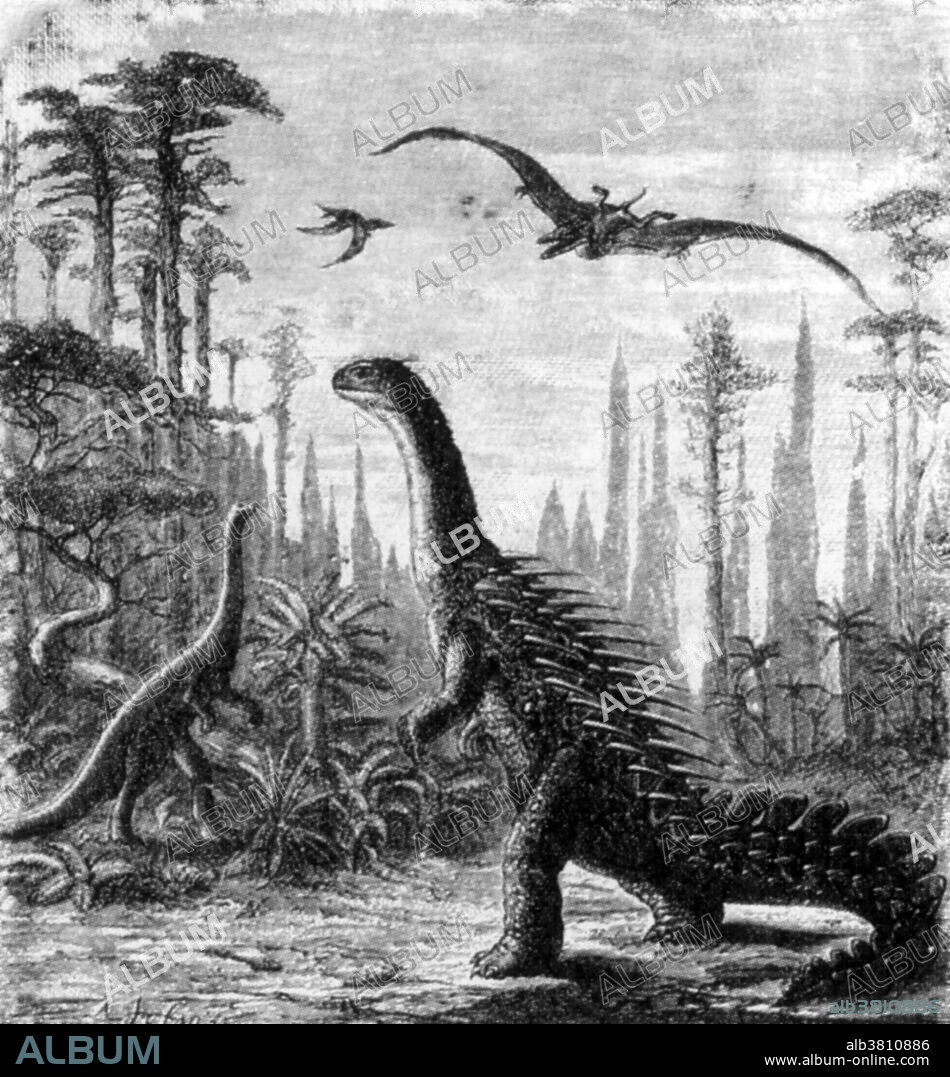alb3810886
Stegosaurus and Compsognathus Dinosaurs

|
Add to another lightbox |
|
Add to another lightbox |



Title:
Stegosaurus and Compsognathus Dinosaurs
Caption:
Dinosaurs of the Jurassic Period: Stegosaurus (right) with Compsognathus (left) and Pterodactyls flying. This inaccurate etching shows an early attempt by Othniel Charles Marsh to reconstruct a plated dinosaur from fossil evidence, with hedgehog spines instead of bony plates. Stegosaurus means "roof lizard" or "plated lizard". One of the various plated dinosaurs (Stegosauria) of the Late Jurassic Period (159 million to 144 million years ago) recognizable by its spiked tail and series of large triangular bony plates along the back. Stegosaurus usually grew to a length of about 21 feet, but some reached 30 feet. The skull and brain were very small for such a large animal. The forelimbs were much shorter than the hind limbs, which gave the back a characteristically arched appearance. The feet were short and broad. They are classified as a quadrupedal herbivorous ornithischian dinosaur. Compsognathus is a genus of small, bipedal, carnivorous theropod dinosaurs. Members of its single species Compsognathus longipes could grow to the size of a turkey. From Scientific American, November 29th, 1884.
Credit:
Album / Science Source / New York Public Library
Releases:
Model: No - Property: No
Rights questions?
Rights questions?
Image size:
3328 x 3588 px | 34.2 MB
Print size:
28.2 x 30.4 cm | 11.1 x 12.0 in (300 dpi)
Keywords:
1884 • 19TH CENTURY • AGE • ÂGÉS • ANIMAL • ANIMALIA • ART • ARTWORK • BIPEDAL • BONY PLATES • BW • CARNIVORE • CARNIVOROUS THEROPOD DINOSAUR • CARNIVOROUS • CHORDATA • COMPSOGNATHUS • DINOSAUR • DINOSAURIA • DINOSAURS • DRAWING • ERA • ETCHING • EXTINCT • EXTINCTION • FAUNA • HERBIVORE • HERBIVOROUS • HISTORIC • HISTORICAL • HISTORY • ILLUSTRATION • INACCURATE • INCORRECT • JURASSIC PERIOD • JURASSIC • LATE JURASSIC PERIOD • MEAT EATER • MEAT EATING • MESOZOIC ERA • MESOZOIC PERIOD • MESOZOIC TIME • MESOZOIC • OLD • ORNITHISCHIAN DINOSAUR • ORNITHISCHIAN • PALAEOBIOLOGY • PALAEONTOLOGY • PALAEOZOOLOGY • PALEOBIOLOGY • PALEONTOLOGY • PALEOZOOLOGY • PERIOD • PLANT EATER • PLANT EATING • PLATED LIZARD • PLATED • PREHISTORIC • PREHISTORY • QUADRUPEDAL HERBIVOROUS ORNITHISCHIAN DINOSAUR • QUADRUPEDAL • REPTIL • REPTILE • REPTILES • REPTILIA • RESTORATION • ROOF LIZARD • SPIKED TAIL • STEGOSAURIA • STEGOSAURUS • TERRESTRIAL VERTEBRATE • THEROPOD • TIME • TRIANGULAR BONY PLATES • VERTEBRATE • WILDLIFE
 Pinterest
Pinterest Twitter
Twitter Facebook
Facebook Copy link
Copy link Email
Email

